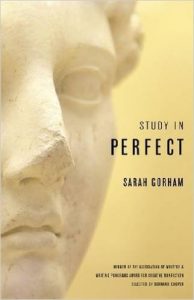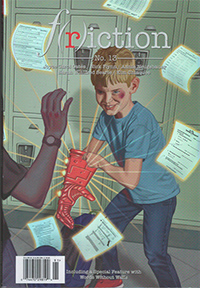Study in Perfect
Sarah Gorham
University of Georgia Press
214 pages
$24.95
Longtime poet and president of Sarabande Books Sarah Gorham makes a successful debut to the world of essay collections with her newest book Study in Perfect. In her introduction, she offers Aristotle’s three interpretive definitions of the word “perfect.” She then continues to explore throughout the book different philosophical, cultural, and touchingly personal standards of perfection and imperfection. The essays vary in topic and length, the longer ones spanning more than twenty pages and delving into complex analyses with multiple through-lines that never get tangled. Sprinkled throughout the book are shorter essays considering individual topics, most less than a page long: “‘Perfect Conversation’ (That which has attained its purpose): ‘I love you.’ ‘I love you too.’”
In her longer essays, Gorham conducts her studies on perfection on both a microscopic and worldly scale. In the essay that opens the book, “Moving Horizontal,” she experiences the transient nature of perfection when she and her husband discover an open-layout home filled with light, a contrast to the Victorian house they raised their children in and once loved. She quotes the architect who designed their new home and establishes a strong voice and thoughtful theme that carries through the rest of the essays. She examines nature and animal behavior, and questions the tendency our species has to impose human characteristics onto everything we see; she speculates about the psychology of the human tendencies to lie and to be selfish and sentimental, drawing opinionated conclusions from both personal experience and scientific fact; she pulls quotes from poets, philosophers, songwriters, historical figures, everyone from Grace Slick to Imelda Marcos.
Although the essays are not strictly autobiographical, Gorham’s life and family are woven deep into the heart of the book. “A Drinker’s Guide to The Cat in the Hat” juxtaposes the classic Dr. Seuss character with the alcoholism that transforms the husband she once viewed as being perfect. “The Changeling” revealingly tells of Gorham’s youngest sister, born microcephalic, and examines her life and its effects on her family. Gorham’s late mother and two adult daughters are also recurring characters in her essays, three generations of women growing up reviewed in “Woman Drawn Twice.” She skillfully mixes inter- and intrapersonal, and widens the scope again with musings on human nature. “We are made of many selves, not just one,” she writes in “On Lying.” “Over a lifetime, we float between honesty and fabrication, between conformity—our dependence on others—and the urge to be separate from them.” Gorham does not hesitate to examine the uglier side of human behavior, and shamelessly uses examples of her own faults to carry her examinations. She describes in one essay how she ignorantly judges a heavyset man she often sees eating plates of French fries in a restaurant, until one day she takes her injured dog to the veterinarian and finds the same man is intelligent, compassionate, and skilled in both healing her beloved animal and calming her nerves. “It takes terrific force to pry open the window in a selfish person’s house,” she writes.
Gorham’s poetic background is apparent in her prose. Her writing is simple yet fluid, lively, and fresh. She sticks largely to a traditional essay format but experiments a little in “The Shape of Fear,” using images from artist Orlagh O’Brien to study fear in the body. This combines for an almost unnervingly physical essay; she writes, “Just the forehead, nose, mouth, throat, and chest. Damp spots in the gut. Fear looks like a mounted insect or a skeleton without the small connecting bones.” Her word choices are natural and evocative, relying, much like her poetry, on rhythm and cadence to carry her essays forward. She includes herself in her essays without making the book actually about herself. Instead, she uses the first person perspective as a jumping-off point to explore her theme of perfection. Although any of her essays could be read alone, it is the skillful compilation that makes it so especially worthy of attention. “Study in Perfect” exemplifies what creative nonfiction can and should be: balanced, explorative, meaningful, honest, and thought-provoking.
Macy Sego, Assistant Editor


